Rethinking Urban Spaces: How City Design Can Drive Sustainable Transport
Urban planning is key to sustainable transport, says UNAM expert Manuel Suárez Lastra. Compact cities with mixed-use zoning encourage walking and cycling, reducing reliance on cars and their carbon footprint.

The future of sustainable urban transport lies not just in electric vehicles, but in fundamentally rethinking how cities are designed, according to Manuel Suárez Lastra, a researcher at the UNAM Geography Institute and general director of Science Dissemination at the National University. In an interview, Mr. Suárez Lastra emphasized the importance of walkable and cyclable cities in reducing reliance on automobiles and mitigating the environmental impact of transportation.
"It is not about your work being two blocks away, but about daily activities such as going to the supermarket, going out to eat or buying basic necessities involving walking distances," Mr. Suárez Lastra said. Research indicates that while most people are receptive to walking and cycling, their willingness extends only to distances of 800 meters (roughly 10-20 minutes) on foot and three kilometers (15-20 minutes) by bike.




